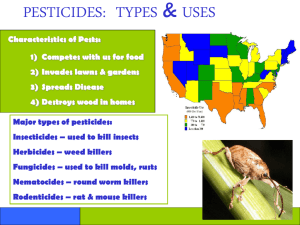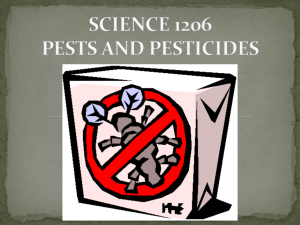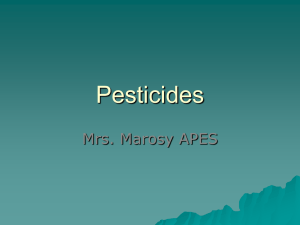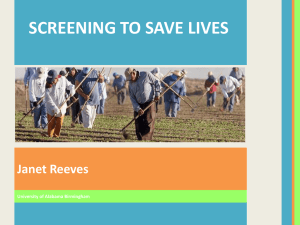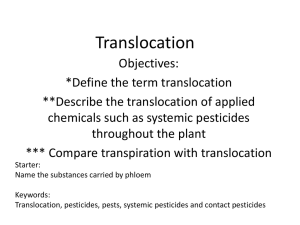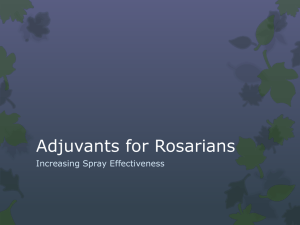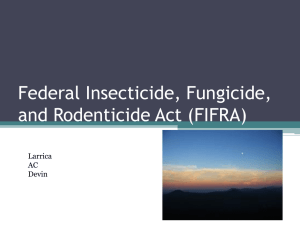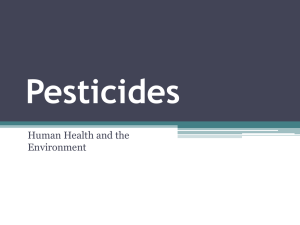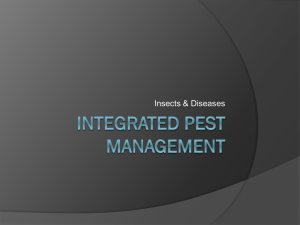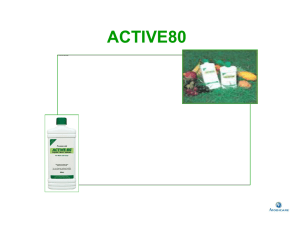FIFRA Federal Insecticide, Fungicide, and Rodenticide Act
advertisement
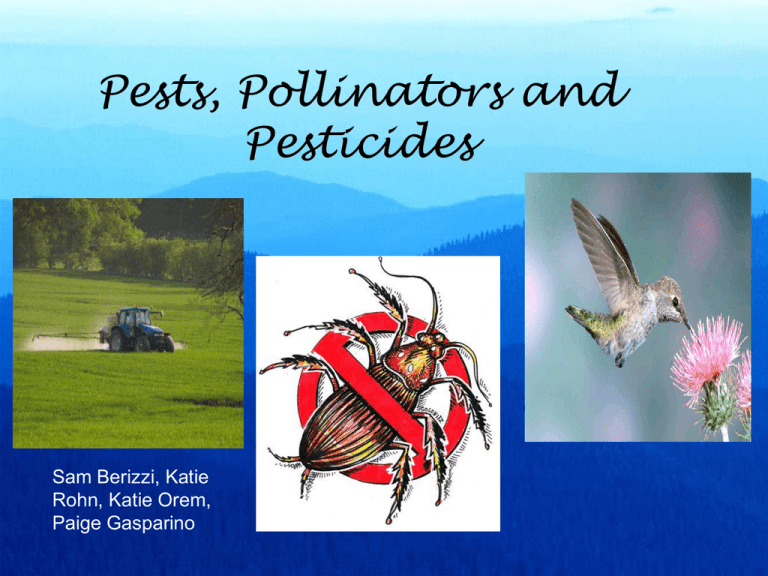
Pests, Pollinators and Pesticides Sam Berizzi, Katie Rohn, Katie Orem, Paige Gasparino Negative and Positive Effects • By their very nature, most pesticides create some risk of harm - Pesticides can cause harm to humans, animals, or the environment because they are designed to kill or otherwise adversely affect living organisms. ( negative) • At the same time, pesticides are useful to society - Pesticides can kill potential diseasecausing organisms and control insects, weeds, and other pests. ( positive) Negative Effects of Pesticides- Food Production • Farmers and their families and other people who use chemical pesticides regularly are at greatest risk for achieving toxic levels in their bodies. • Pesticides are carried on through wind, leaves, residue on produce, remain inside produce and animals, and run off into open water contaminating public water Pests • Pests damage crops that are valuable to our food production • Pests compete with our crops initially because they are like every other biotic being, they try to survive and reproduce Pesticides • Targeting pests and animals by using pesticides effects the agriculture that is being sprayed as well. • Three quarters of the pesticides are applied to agricultural land • 32 million is spent on pesticides, with one third of the total spent in the U.S. Persistence of pesticides • Break down easily= less persistent • Don’t break down easily= more persistent • The Chemical ( pesticide) has the ability to obtain its molecules and maintain its physical, chemical and functional characteristics through the environment • The chemicals are easily transported with out being lost Pollution • Because Pesticides are easily transmitted through run off which consequently goes into the water we drink we have to be careful of how we transport the pesticides to the pests. • Pesticides also cause pollution that we consume directly from the atmosphere and the air. • Fruit and vegetables most likely to be contaminated with pesticides include: apples, bell peppers, celery, cherries, grapes, nectarines, peaches, pears, potatoes, raspberries, spinach, and strawberries. “Coevolution” • The mutual evolutionary influence between two species- usual mutualismdependent on one another. • The number of species know to have evolved resistance to pesticides have grown over the decades. Relationships • Pesticides and Plants are a prime example of coevolution mainly because the relationship is predator and prey in this situation because one gets affected which is the pests and the pesticides initially take over the land that the pests were invading ( Brennan 269) “Pesticide Treadmill” • As one uses a pesticide, individuals that are not killed by it pass on their traits so they are therefore resistant to the pesticide. • Their offspring inherit the same traits, making them resistant to the pesticide as well • For example- If an insect that survive from the pesticide mates with another insect that is resistant of the same pesticide, the population will begin to go. • The pesticide applications will cease to be effective any longer Effects of the “Treadmill” • Because more pests are becoming resistant to pesticides this causes farmers to adopt new and more potent poisons. • There is no end to the toxic spiral! Facts about Resistance • As of 2007 there were more than 2700 know cases of resistance by 550 species to over 300 pesticides ( Brennan & Withgott 269) Broad Spectrum Pesticides • Insecticides ( pesticide used against insects) that are not selective, but may be even more toxic to the natural enemy than to the pest or have an impact on a wide range of pests and natural enemies, are called broad-spectrum. • This broad spectrum pesticide overall has a worse effect on the land and the crops we “attempt” to grow • Kill many kinds of pests Examples of BSP • organophosphate (e.g., malathion, dimethoate) • carbamate (e.g., carbaryl–Sevin, methomyl–Lannate) • pyrethroid (e.g., cyfluthrin–Baythroid, fenpropathrin–Danitol) • foliar-applied neonicotinoid (imidacloprid– Provado, acetamiprid–Assail) insecticides. Narrow Spectrum (selective) Pesticides • These are developed to kill specific organism types and are good at doing so http://mikesansone.typepad.com/photos/uncategorized/pests.jpg Examples of NSP • • • • Examples are algicides for algae avicides for birds fungicides for fungi oomycetes (also called water molds, they use surface water including precipitation on plants, to move around). “ Ideal Pesticides” • The ideal pesticide is a molecule which is capable of being delivered and can act on a specific species/organism with no harmful effects on surround environments. • Pesticides do not harm crops that are present in the specific ecosystems where the pesticide is taking out the pest. • Not to much toxicity (Cloyd 1) First Generation Pesticides • Contain primarily natural substances • Consists of sulfur, lead, tobacco, arsenic and mercury compounds • Acts as an insecticide, which kills of insects to protect crops • 2 types: pyrethrum and rotenone • Pyrethrum is accessed through the heads of chrysanthemum flowers • Rotenone is obtained from the roots of different types of tropical forest legumes Second Generation Pesticides • Includes insecticides, herbicides and fungicides • Insecticides- kills insects • Herbicides- kills weeds • Fungicides- kills fungi • Nematocides- kills roundworms • Rodenticides- kills rats/mice Types of Insecticides • Chlorinated hydrocarbons- Many different types of organic molecules • Organophosphates- Affect an important enzyme called acetylcholinesterase, which is found in insects • Carbamates- Consists of inorganic compounds • Botanicals- Consists of chemicals that are taken from plants (natural chemicals), not as toxic as other insecticides • Microbotanicals- Taken from small parts of plants • • • • • Insecticides: DDT (dichlorodiphenyltrichloroethane) Type of pesticide known since 1874 Also known as the “atomic bomb” of pesticides It is the first of the second generation pesticides It is the world’s most popular pesticide In the past DDT has been known to kill of pests for both health and agricultural purposes (potato beetles, coddling moth, corn earthworm, cotton bollworm, tobacco budworms) • June 1972: people began to worry about the negative environmental and heath relations to DDT and the US Environmental Protection Agency banned its use • However, other countries (mostly tropical) continue to use the harmful chemical Insecticides: Malathion • Registered in United States in 1956 • Purpose is to kill mosquitoes (adults) is private gardens, agricultural areas, and public recreation areas • It is meant to have very few risks in terms of human health • Few toxins are evident in the environment after malathion use • Malathion’s effects are still debated over in the Environmental Protection Agency Insecticides: Carbaryl • Became popular in US in the 1970s • Used for insects on fruit, cotton, lawns, forests, nuts, and even poultry • Highly toxic • Can show harmful effects to humans, aquatic animals, and non-target insects • However, it shows little damage in birds • Used in powder form Insecticides: Chlordane • It was prevalent in the United States until 1983 • Its uses range from protecting private gardens to yards as well as some important crops (corn, citrus) • 1983- Chlordane was partially banned (some of its uses, not its use against termites) by the EPA • 1988- Fully banned due to the belief that it may contribute to testicular cancer and Insecticides: Dieldrin • A by-product of a pesticide called Aldrin • Popular from 1950 to 1974 for the management of insects on different crops • In 1987 it was prohibited for its toxicity • Because of the harmful effects, it is not being produced in the United States anymore • Potential effects: – Harmful to immune system, kidneys and reproductive system – Possible link to cancer and birth defects Herbicides: Atrazine • Used primarily on cornfields to eliminate weeds that damage the crops • Remains highly popular today because of its effectiveness • It is moderately toxic to both humans and animals, possible negative long-term heath effects • Has been found in groundwater in many different areas damaging water supply Fungicides: Formaldehyde • It has many curing aspects that make it an innovative ingredient in fungicides • It is useful because it does not have a strong negative affect on the organism it is applied to and is therefore less toxic than the main components of past fungicides Sources • http://www.tarleton.edu/~cthompson/ES3503//Pesticid es.html • http://users.rcn.com/jkimball.ma.ultranet/BiologyPages /I/Insecticides.html • http://www.atsdr.cdc.gov/tfacts31.html • http://www.epa.gov/opp00001/health/mosquitoes/mala thion4mosquitoes.htm • http://extoxnet.orst.edu/pips/carbaryl.htm • http://www.epa.gov/pbt/pubs/aldrin.htm • http://www.water-research.net/atrazine.htm • http://www.patentstorm.us/patents/4356179/descriptio n.html FIFRA Federal Insecticide, Fungicide, and Rodenticide Act 1947, amended in 1972 Objective: provide federal control of pesticide distribution, sale, and use. All pesticides in the US must be registered by the EPA, registration assures that the pesticides will be properly labeled and if used in accordance with specifications, they will not cause damage. Amendments led to the specific authorization of the EPA to 1) Strengthen the registration process by shifting the burden of proof to the chemical manufacturer 2) Enforce compliance against banned and unregistered products 3) Propose the regulatory framework missing from the original law http://www.epa.gov/oecaagct/lfra.html FQPA Food Quality Protection Act of 1996 • Congress presented the EPA with an enormous challenge of changing the way they evaluate and regulate pesticides. • The FQPA amended the FIFRA and FFDCA (Federal Food Drug & Cosmetic Act) Requirements Stricter safety standards, especially for infants & children Complete reassessment of all existing pesticide tolerances The bill was said to be a, “landmark bipartisan agreement that will bring Federal regulation of the Nation’s food producers into the 21st century” by the House Commerce Committee Chairman Bliley http://www.epa.gov/opp00001/regulating/laws/fqpa/ Bacillus Thuringiensis (Bt) • A naturally occurring bacterium common in soils around the world • Only “microbial insecticide” in widespread use • Bt insecticides usually are used against leaf-and needlefeeding caterpillars. Strains have been produced that affect certain fly larvae like mosquitoes • Bt is safe concerning people and nontarget species, like wildlife, it is no threat to food crops • Occasionally the bacteria enter the insect’s blood and reproduce within the insect, most insects’ reaction to the protein crystal is lethal • Susceptible to degradation by sunlight • Does not kill rapidly, short shelf life http://www.ext.colostate.edu/pubs/Insect/0 5556.html Cactus Moth Cactoblastis Objective: destroy prickly pear cacti This organism has been used from Australia to South Africa as a biocontrol agent to remove the plants from agricultural lands, where cacti are seen as problematic Now, the cactus moth is becoming invasive in areas such as the Australia, the Caribbean, Alabama, and Florida. It is attacking native prickly pear that are rare to the area “The cactuses also play an important role in holding soil in desert systems as well. We would likely see some problems with soil erosion, which can really be severe in the desert once you lose that fragile cover.” John Randall (director of The Nature Conservancy’s Global Invasive Species Initiative) Hawaiian Yellowjacket Wasps “Little vacuum cleaners” • Disrupt native populations of insects and spiders • Kill/ scavenge prey from 14 different taxonomic orders, including reptiles and birds • Invasive due to flexible diet • Besides killing, they collect large amounts of nectar, decreasing the accessibility of other resources “Rather than having a nest the size of a football, you’ll have a nest the size of a ’57 Buick,” Erin Wilson (lead author of the study reported in the Proceedings of the National Academy of Sciences) http://ucsdnews.ucsd.edu/newsrel/science/ 07-09InvasiveWasps.asp IPM programs use current, comprehensive information on the life cycles of pests and their interaction with the environment. This information, in combination with available pest control methods, is used to manage pest damage by the most economical means, and with the least possible hazard to people, property, and the environment. (http://www.epa.gov/opp00001/factsheets/ipm.htm) The use of multiple techniques in combination to achieve longterm suppression of pests, including biocontrol, use of pesticides, close monitoring of populations, habitat alteration, crop rotation, transgenic crops, alternative tillage methods, and mechanical pest removal. (textbook) Conservation of Pollinators is Vital. Pollinators are the unsung heroes of agriculture. Pollination is the process by which pollen is transferred in plants, thereby enabling fertilization and sexual reproduction.

